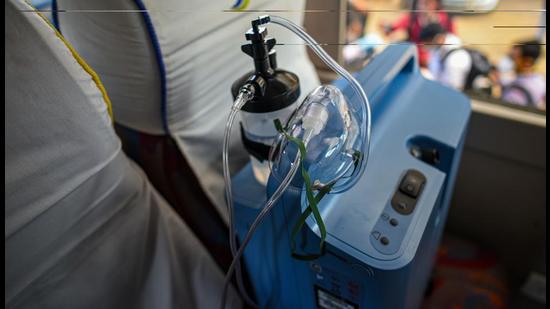What’s behind India’s acute shortage of life-saving medical devices?
Most modern medical devices, on the inside, have high-end electronic components. The biomedical and electronics industries were trying to shift supply lines away from China when the pandemic hit, following India’s border conflagration with the neighbour in 2020
When the coronavirus pandemic first hit India in 2020, the import-dependent medical devices industry — a cornerstone of the country’s health sector — was already in a churn, scrambling to establish new sources of raw materials and supply lines. This uncertainty would only prove catastrophic when a deadlier second wave suddenly took hold this summer.

Most modern medical devices, on the inside, have high-end electronic components. The biomedical and electronics industries were trying to shift supply lines away from China when the pandemic hit, following India’s border conflagration with the neighbour in 2020.
The industry is still caught in that transition, manufacturers said. Challenging problems of sourcing of raw materials in the electronics sector have rippled on to the medical-devices industry, experts point out.
The crisis
The second Covid wave, which has now shown signs of ebbing, brought India’s public health system to its knees. Shortages of life-saving equipment, from ventilators to oxygen concentrators, was at the heart of the crisis. Policies to incentivise domestic manufacturing of medical gear need a relook if the country is to stave off a similar situation in future, experts said.
“During the second wave, in which there was a markedly higher demand for oxygen compared to the first wave, we simply could not cope with the demand,” said Shanta Kumar, the managing director of Southern Electronics (Bangalore) Pvt Ltd. Kumar’s company primarily makes oxygen concentrators and is affiliated to the Association of Indian Medical Device Industry, a lobby group. According to Kumar, the medical devices industry has apprised the government of critical issues faced by the industry, such as the issue of sourcing.
The Indian medical devices sector, which has the highest potential within the health care market, was valued at ₹50,026 crore for 2018-19, according to latest official figures available. It is expected to reach to ₹86,840 crore by 2021-22. India depends on imports of up 85% to meet its total domestic demand for medical devices.
Also Read | India runs the risk of losing its pharma edge
Indian manufacturers, who imported nearly ₹43,000 crore worth of medical equipment in 2018-19, haven’t been able to take enough advantage of key policies intended to boost domestic production due to a painful transition to alternative suppliers forced by India’s conflict with China, a large supplier of raw materials for India.
The government’s push and its limits
The government has a clutch of schemes running to boost domestic manufacturing medical devices. Two of these were approved by the Cabinet on March 21, 2020.
One is the performance-linked incentive (PLI) scheme to boost domestic manufacturing of medical devices worth ₹3,420 crore over the next five fiscals.
Two, the government also launched a scheme to finance promotion of medical device parks for bulk production with common infrastructure facilities in four designated medical device parks. The programme is worth ₹400 crore. The scheme for promotion of medical device parks also covers cancer-care devices, imaging devices, cardio-respiratory gear, cochlear implants and pacemakers.
The PLI scheme offers eligible manufacturing companies and sectors a 4-6% incentive on incremental sales over the base year of 2019-20 for a five-year period. When a firm achieves a given sales target, it qualifies for the incentive. Since the electronics industry, which supplies to medical-equipment manufacturers, began shifting supply lines away from China in 2020, the “base year of 2019-20” designed into the PLI scheme for medical goods has proven to be of no help, analysts say.
Here’s why. The base year is not simply a cut-off date. It has far-reaching consequences for the performance of the PLI scheme, especially in the electronics and medical devices sector.
Also Read | Local trials for Covid shots scrapped to fast-track imports
“The PLI scheme captures (sales) milestone over a base year of production. If you change the base year to 2021 from the existing 2020, then you can tackle a lot of these sourcing issues,” said economist Pronab Sen. Changing the base year to 2021 from 2020 would “base” the scheme in the year when supply disruptions have been most acute. “So, there is a fair amount of legitimacy to the demand to change the base year, but so far, the government hasn’t taken any decision,” Sen added.
Switching the year base to 2021 will mean the industry doesn’t lose a precious year of financial incentives, because currently, it is focusing on transitioning to new supply sources, rather than ramping up manufacturing.
Prior to the border dispute with China, supplies were not a problem. Firms are still scrambling for alternative suppliers, whose specifications may not be the same as old suppliers, experts say.
The changes in specifications require new production lines to be established, which could take up to a year, even as India battles a shortage of medical equipment, Sen said.
A way forward on PLI scheme
Firms have also demanded hiking the 5% incentive of the PLI scheme in the medical devices sector to 10%, which is the incentive rate for the auto sector, for instance. “This will automatically give policy primacy to the medical industry,” said a spokesperson of Unisur Lifecare Private Limited, also affiliated to the Association of Indian Medical Device Industry.
A top-level meeting was held early this month to review all current schemes available to the bio-medical goods and phama sectors, an official of the DV Sadananda Gowda-headed chemical and fertilizers ministry said, requesting not to be quoted.
The government may restructure the PLI scheme to focus on manufacturers of medical equipment needed for the “fight and containment of Covid-19”, the official said.
All Access.
One Subscription.
Get 360° coverage—from daily headlines
to 100 year archives.



HT App & Website







